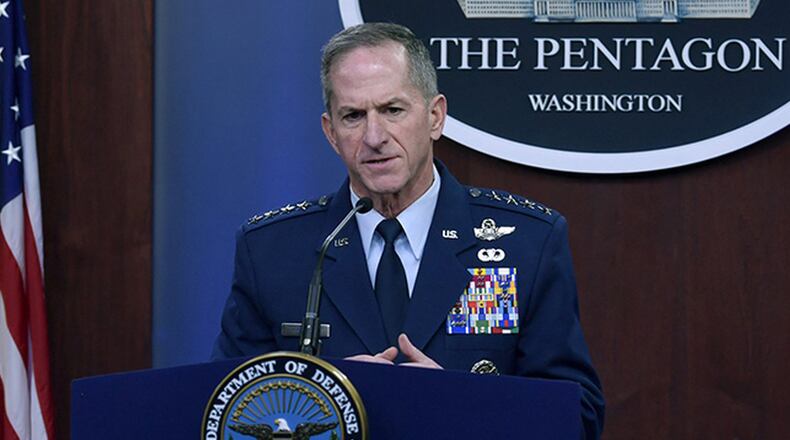He said the “training pipeline” is still operating and that the nuclear deterrent has had no change in operations.
Even so, Goldfein conceded that the Air Force has had to adapt to “keep the force size we need to maintain the missions.” That is especially challenging when serving bases in so-called Level 3 nations such as Italy and South Korea where the rate of infection is high.
“Global mobility into and out of Level 3 countries has to continue,” Goldfein said. “And so (there) are measures in place that isolate the (flight) crew, mitigate the risk so we can fly into (those countries) knowing that the global landscape will change.”
Among other actions, Goldfein said aircrews have their temperatures taken and that social distancing is rigorously enforced.
“We consider the aircraft itself a clean environment and while they’re in that aircraft, they are not in an environment that is a concern,” he said. “It’s when they leave that aircraft to go to their rooms … we’re minimizing movement and keeping them in a bubble to make sure we can keep the force size we need.”
Additionally, Goldfein outlined the steps the Air Force is taking to increase odds that the 685,000 active-duty, Guard and Reserve force as well as civilians are protected as much as possible from a virus for which there is no vaccine or immunity.
Goldfein said he and other senior leaders are stressing adherence to basic actions such as social distancing, frequent handwashing and prompt treatment if symptoms emerge. To underscore the need to be vigilant and disciplined, Goldfein said he was teleworking several days each week and has communicated with commanders the importance of adhering to federal guidelines for minimizing exposure to the virus.
Air Force Surgeon General Lt. Gen. Dorothy A. Hogg, who joined Goldfein at the news conference, said she expects the number of confirmed cases to increase across the Air Force.
“We do know our cases will increase just like they are in the general public,” Hogg said. “We are paying attention to those cases and identifying contacts and implementing measures to decrease exposures – social distancing, single-point entries into medical clinics – to make sure we’re separating the two populations if someone was ill.”
While the core missions continue, the pandemic has had an effect.
Exercises have been postponed, including a Red Flag exercise planned for Alaska and a high-profile test of the Advanced Battle Management System next month. That exercise was the latest installment of the move to a fully connected battle network approach to warfighting known as Joint All Domain Command and Control. The full Joint Chiefs of Staff was expected to attend the April demonstration.
Goldfein said the Air Force is ready to help other agencies respond to the pandemic, noting the Air Force’s long standing ability to transport equipment and infected people if needed.
As an example, he highlighted a delivery this week of 500,000 COVID-19 test swabs that an Air Force C-17 Globemaster III flew from Italy to Memphis, Tennessee. The swabs were then loaded onto an commercial aircraft and distributed around the country to locations identified by the Department of Health and Human Services
“I don’t see any limitation in terms of our ability to move the test kits and the things that HHS is asking for,” he said.
About the Author
